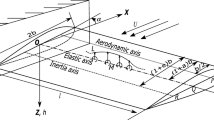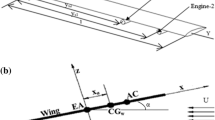Abstract
In this work, a stochastic finite element method based on first order perturbation approach is developed for the probabilistic flutter analysis of aircraft wing in frequency domain. Here, both bending and torsional stiffness parameters of the wing are treated as Gaussian random fields and represented by a truncated Karhunen–Loeve expansion. The aerodynamic load on the wing is modeled using Theodorsen’s unsteady aerodynamics based strip theory. In this approach, Theodorsen’s function, which is a complex function of reduced frequency, is also treated as a random field. The applicability of the present method is demonstrated by studying the probabilistic flutter of cantilever wing with stiffness uncertainties. The present method is also validated by comparing results with Monte Carlo simulation (MCS). From the analysis, it is observed that torsional stiffness uncertainty has significant effect on the damping ratio and frequency of the flutter mode as compared to bending stiffness uncertainty. The probability density functions of damping ratio and frequency using perturbation technique and MCS are also discussed at various free stream velocities due to stiffness uncertainties. Furthermore, the flutter probability of the cantilever wing is studied by defining implicit limit state function in conditional sense on flow velocity for the flutter mode. Both perturbation and MCS are considered to study the flutter probability of the wing. From the cumulative distribution functions of flutter velocity, it is noticed that the presence of uncertainty in torsional rigidity lowers the predicted flutter velocity in comparison to uncertainty in bending rigidity.














Similar content being viewed by others
Change history
03 March 2021
A Correction to this paper has been published: https://doi.org/10.1007/s11012-021-01324-4
08 January 2020
A Correction to this paper has been published: https://doi.org/10.1007/s11012-019-01113-0
References
Adhikari S, Friswell MI (2001) Eigenderivative analysis of asymmetric non-conservative systems. Int J Numer Methods Eng 51(6):709–733
Beran P, Stanford B, Schrock C (2017) Uncertainty quantification in aeroelasticity. Annu Rev Fluid Mech 49:361–386
Beran PS, Pettit CL, Millman DR (2006) Uncertainty quantification of limit-cycle oscillations. J Comput Phys 217(1):217–247
Borello F, Cestino E, Frulla G (2010) Structural uncertainty effect on classical wing flutter characteristics. J Aerosp Eng 23(4):327–338
Bueno DD, Góes LCS, Gonçalves PJP (2015) Flutter analysis including structural uncertainties. Meccanica 50(8):2093–2101
Canor T, Caracoglia L, Denoël V (2015) Application of random eigenvalue analysis to assess bridge flutter probability. J Wind Eng Ind Aerodyn 140:79–86
Castravete SC, Ibrahim RA (2008) Effect of stiffness uncertainties on the flutter of a cantilever wing. AIAA J 46(4):925–935
Cheng J, Xiao RC (2005) Probabilistic free vibration and flutter analyses of suspension bridges. Eng Struct 27(10):1509–1518
Dai Y, Yang C (2014) Methods and advances in the study of aeroelasticity with uncertainties. Chin J Aeronaut 27(3):461–474
Danowsky BP, Chrstos JR, Klyde DH, Farhat C, Brenner M (2010) Evaluation of aeroelastic uncertainty analysis methods. J Aircr 47(4):1266–1273
Desai A, Sarkar S (2010) Uncertainty quantification and bifurcation behavior of an aeroelastic system. In: ASME 3rd joint US-European fluids engineering summer meeting and 8th international conference on nanochannels, microchannels, and minichannels, Montreal, Canada, Paper No. FEDSM-ICNMM2010-30050
Friswell MI, Adhikari S (2000) Derivatives of complex eigenvectors using Nelson’s method. AIAA J 38(12):2355–2357
Fung YC (2008) An introduction to the theory of aeroelasticity. Courier Dover Publications, Mineola
Ghanem R, Ghosh D (2007) Efficient characterization of the random eigenvalue problem in a polynomial chaos decomposition. Int J Numer Methods Eng 72(4):486–504
Ghanem RG, Spanos PD (2003) Stochastic finite elements: a spectral approach. Courier Corporation, Chelmsford
Goland M (1945) The flutter of a uniform cantilever wing. J Appl Mech Trans ASME 12(4):A197–A208
Guedria N, Chouchane M, Smaoui H (2007) Second-order eigensensitivity analysis of asymmetric damped systems using Nelson’s method. J Sound Vib 300(3–5):974–992
Hassig HJ (1971) An approximate true damping solution of the flutter equation by determinant iteration. J Aircr 8(11):885–889
Huang SP, Quek ST, Phoon KK (2001) Convergence study of the truncated Karhunen–Loeve expansion for simulation of stochastic processes. Int J Numer Methods Eng 52(9):1029–1043
Irani S, Sazesh S (2013) A new flutter speed analysis method using stochastic approach. J Fluid Struct 40:105–114
Irwin C, Guyett PR (1965) The subcritical response and flutter of a swept-wing model. HM Stationery Office, Richmond
Khodaparast HH, Mottershead JE, Badcock KJ (2010) Propagation of structural uncertainty to linear aeroelastic stability. Comput Struct 88(3–4):223–236
Kleiber M, Hien TD (1992) The stochastic finite element method: basic perturbation technique and computer implementation. Wiley, Hoboken
Kurdi M, Lindsley N, Beran P (2007) Uncertainty quantification of the \(\text{Goland}^+\) wing’s flutter boundary. In: AIAA atmospheric flight mechanics conference and exhibit, Hilton Head, South Carolina, Paper No. 2007-6309
Le Maître O, Knio OM (2010) Spectral methods for uncertainty quantification: with applications to computational fluid dynamics. Springer, Berlin
Marques S, Badcock KJ, Khodaparast HH, Mottershead JE (2010) Transonic aeroelastic stability predictions under the influence of structural variability. J Aircr 47(4):1229–1239
Melchers RE (1999) Structural reliability analysis and prediction, 2nd edn. Wiley, Hoboken
Murthy DV, Haftka RT (1988) Derivatives of eigenvalues and eigenvectors of a general complex matrix. Int J Numer Methods Eng 26(2):293–311
Pettit CL (2004) Uncertainty quantification in aeroelasticity: recent results and research challenges. J Aircr 41(5):1217–1229
Pitt D, Haudrich D, Thomas M, Griffin K (2008) Probabilistic aeroelastic analysis and its implications on flutter margin requirements. In: 49th AIAA/ASME/ASCE/AHS/ASC structures, structural dynamics, and materials conference, 16th AIAA/ASME/AHS adaptive structures conference, 10th AIAA non-deterministic approaches conference, 9th AIAA gossamer spacecraft forum, 4th AIAA multidisciplinary design optimization specialists conference, Schaumburg, IL, Paper No. 2008-2198
Pourazarm P, Caracoglia L, Lackner M, Modarres-Sadeghi Y (2016) Perturbation methods for the reliability analysis of wind-turbine blade failure due to flutter. J Wind Eng Ind Aerodyn 156:159–171
Reddy JN (2017) An introduction to finite element method, 3rd edn. McGraw-Hill, New York
Riley ME, Grandhi RV (2014) Quantification of modeling-induced uncertainties in simulation-based analyses. AIAA J 52(1):195–202
Riley ME, Grandhi RV, Kolonay R (2011) Quantification of modeling uncertainty in aeroelastic analyses. J Aircr 48(3):866–873
Theodorsen T (1935) General theory of aerodynamic instability and the mechanism of flutter. Tech. Rep. NACA 496
Ueda T (2005) Aeroelastic analysis considering structural uncertainty. Aviation 9(1):3–7
Van Trees HL (2004) Detection, estimation, and modulation theory. Wiley, Hoboken
Verhoosel CV, Scholcz TP, Hulshoff SJ, Gutiérrez MA (2009) Uncertainty and reliability analysis of fluid-structure stability boundaries. AIAA J 47(1):91–104
Wang X, Qiu Z (2009) Nonprobabilistic interval reliability analysis of wing flutter. AIAA J 47(3):743–748
Wu S, Livne E (2017) Alternative aerodynamic uncertainty modeling approaches for flutter reliability analysis. AIAA J 55(8):2808–2823
Yao G, Zhang Y (2016) Reliability and sensitivity analysis of an axially moving beam. Meccanica 51(3):491–499
Yao G, Zhang Y, Li C (2018) Aeroelastic reliability and sensitivity analysis of a plate interacting with stochastic axial airflow. Int J Dyn Control 6(2):561–570
Funding
The authors received no financial support for the research, authorship, and/or publication of this article.
Author information
Authors and Affiliations
Corresponding author
Ethics declarations
Conflict of interest
The authors declared no potential conflicts of interest with respect to the research, authorship, and/or publication of this article.
Additional information
Publisher's Note
Springer Nature remains neutral with regard to jurisdictional claims in published maps and institutional affiliations.
Appendix
Appendix
The weak forms of the governing Eqs. (5) and (6) are obtained by multiplying weight functions \(v_1\) and \(v_2\) respectively and integrating over an \(i^{th}\) element length as [32]:
Substituting the expressions for lift (L) and moment (M), and performing integration by parts, the above equations can be expressed as:
where \(M^b\), \(S^b\), and \(\tau\) are bending moment, shear force, and torsional moment respectively and can be written as:
Now by using finite element approximation functions, the heave (h) and pitch \((\alpha )\) displacements can be expressed as:
where \(\lfloor N_w\rfloor =\lfloor N_1, N_2, N_3, N_4\rfloor\) and \(\lfloor N_\alpha \rfloor =\lfloor \bar{N}_1,\bar{N}_2\rfloor\) are Hermite and Lagrange shape functions [32] respectively and \(\{w_e\}\) and \(\{\alpha _e\}\) are the bending and torsional degrees of freedom respectively. The weight functions \(v_1\) and \(v_2\) can be also written as \(v_1= \lfloor N_w\rfloor ^T\) and \(v_2=\lfloor N_\alpha \rfloor ^T\) respectively. On substitution of the above approximation functions and weight functions, the elemental equations can be written in notational form as:
where \(\{F_i\}=\lfloor -S_{y_{i}}^{b}, -M_{y_{i}}^{b}, S_{y_{i+1}}^{b}, M_{y_{i+1}}^{b}\rfloor ^T\) and \(\{\tau _i\}=\lfloor -\tau _{y_i},\tau _{y_{i+1}}\rfloor ^T\). The terms involved in Eq. (48) are:
and the terms in Eq. (49) can be written as:
Rights and permissions
About this article
Cite this article
Kumar, S., Onkar, A.K. & Maligappa, M. Frequency domain approach for probabilistic flutter analysis using stochastic finite elements. Meccanica 54, 2207–2225 (2019). https://doi.org/10.1007/s11012-019-01061-9
Received:
Accepted:
Published:
Issue Date:
DOI: https://doi.org/10.1007/s11012-019-01061-9




